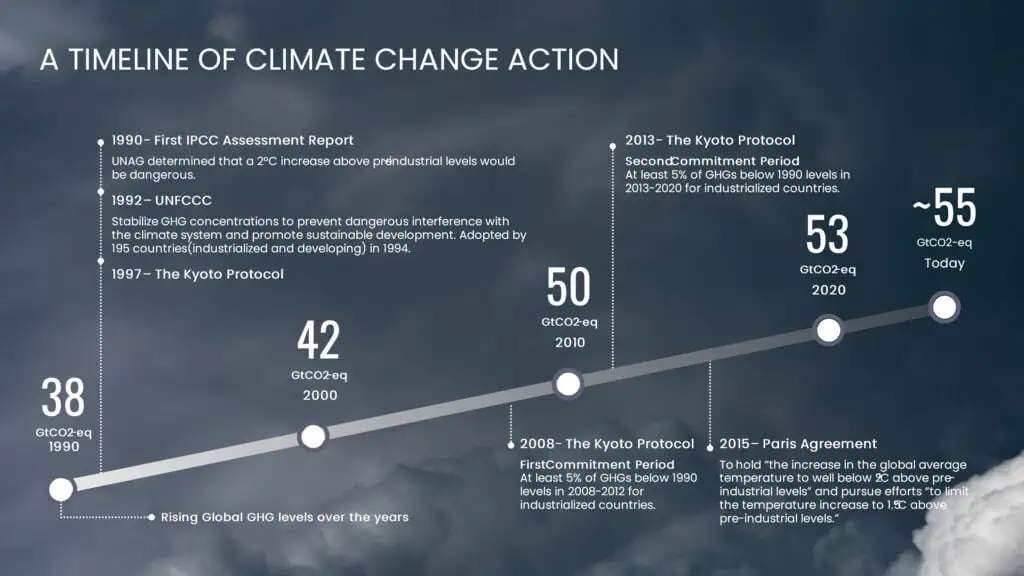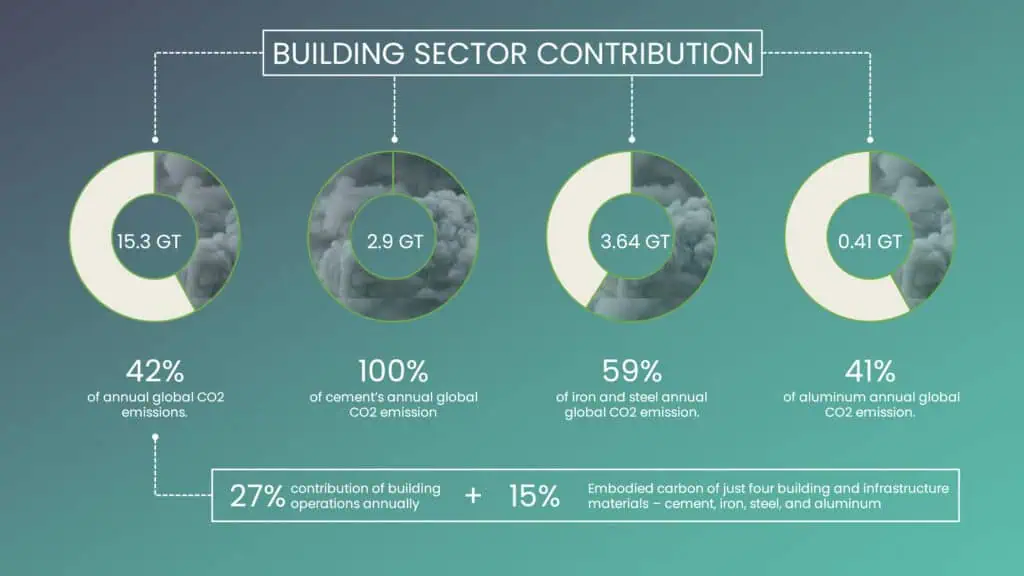“Greenhouse gas emissions keep growing. Global temperatures keep rising. And our planet is fast approaching tipping points that will make climate chaos irreversible. We are on a highway to climate hell with our foot on the accelerator.”
– António Guterres, Secretary-General of the United Nations
In the past century, industrialization and technological advances have ushered in progress and prosperity, but at a steep cost: a surge in greenhouse gas emissions, which has propelled the urgent climate crisis. As we confront these environmental consequences, there’s a growing recognition of the need for immediate action. Human activities, primarily through greenhouse gas emissions, have undeniably triggered global warming, pushing global temperatures 1.1°C above pre-industrial levels in 2011-2020.
This realization is fueling a global and organizational response. Businesses are increasingly adopting sustainability measures, cutting emissions, and embracing renewable energy. Governments and international efforts have set ambitious targets, while public and investor pressure heightens the urgency.
Addressing this issue is not just a moral imperative; it closely aligns with overarching sustainability goals, demanding concerted action to strengthen the global commitment to sustainability, resilience and social impact. Organizations must proactively reconsider their role in shaping a sustainable future.
An Immediate Imperative
Climate change compels us to recognize the necessity of immediate action on multiple fronts. To delay meaningful intervention is to exacerbate the consequences of this complex and pressing issue. The urgency is underscored by a multitude of compelling reasons, each grounded in empirical evidence and recognized on an international scale. From safeguarding vulnerable populations and ecosystems to preserving economic stability and fostering innovation, the imperative for immediate climate action is rooted in the profound and interconnected challenges it presents.

Climate Change Action
In recent decades, a substantial rise in average global temperatures, primarily attributed to human activities, has triggered widespread consequences affecting ecosystems, economies, and societies worldwide. Climate change action, a resolute response to the immediate imperative of shifting climate patterns, has evolved into a global priority that transcends environmental concerns to encompass justice, human rights, and sustainable development.
Evolution
Over time, climate change action has shifted from a primary focus on awareness-raising to a comprehensive strategy involving both mitigating greenhouse gas emissions and adapting to ongoing changes. This evolution recognizes that the impacts of climate change are immediate challenges, especially for vulnerable communities.
The transformation in climate change action is evident in the increased emphasis on concrete measures, such as international cooperation and technological advancements. This journey towards climate agreements reflects a growing consensus on the necessity of collaborative efforts to reduce emissions. Specific initiatives, like the development of renewable energy technologies and sustainable practices, have become integral to addressing the dynamic challenges of climate change.

The Conference of the Parties (COP)
In 1992, the Conference of the Parties (COP) emerged as a key mechanism under the United Nations Framework Convention on Climate Change (UNFCCC), established during the Earth Summit in Rio de Janeiro.
Significance:
COP serves as the central platform for international cooperation on climate change. It brings together representatives from around the world to negotiate, set targets, and develop global climate policies. Through this process, countries can collectively assess progress, share strategies, and strengthen commitments to reduce greenhouse gas emissions. Over time, the COP has evolved through critical milestones, shaping the global response to climate challenges and driving the transition towards a more sustainable future.
- COP 3 (1997) – Kyoto: The Kyoto Protocol was adopted at COP 3 in Kyoto, Japan, marking a significant step in global climate governance. It was the first international treaty to set legally binding emissions reduction targets for developed countries, recognizing their historical responsibility for greenhouse gas emissions.
- COP 21 (2015) – Paris:
Held in Paris, COP 21 resulted in the historic Paris Agreement, a legally binding international treaty on climate change adopted by 196 countries. It marked a turning point in global climate action by setting a shared long-term goal to limit global warming to well below 2°C, with efforts to keep it below 1.5°C above pre-industrial levels.
Key Objectives of the Paris Agreement:
- Temperature Goal: Limit the rise in global average temperature to well below 2°C and pursue efforts to limit it to 1.5°C.
- Adaptation and Resilience: Strengthen countries’ ability to adapt to the adverse impacts of climate change and foster climate resilience.
- Climate Finance and Sustainable Pathways: Align financial flows with low greenhouse gas emissions and climate-resilient development.
CO2 – The Main Orchestrator
Carbon dioxide (CO2) stands as Earth’s foremost greenhouse gas, playing a critical role in our planet’s climate. Unlike inert gases like oxygen and nitrogen which make up the majority of our atmosphere, greenhouse gases possess the unique ability to trap and reradiate heat from the Earth’s surface. Without carbon dioxide, the natural greenhouse effect would be too weak to maintain global temperatures above freezing.
According to data from the NOAA14 Global Monitoring Lab in 2021, carbon dioxide alone accounted for about two-thirds of the total heating influence caused by human-produced greenhouse gases. These findings underscore the urgency of addressing carbon dioxide emissions and the broader issue of climate change on a global scale.

Nationally Determined Contribution
A Nationally Determined Contribution (NDC) is a non-binding national climate action plan that outlines a country’s strategies to reduce greenhouse gas emissions and adapt to the impacts of climate change. These plans are central to achieving the goals of the Paris Agreement and reflect each country’s commitment to global climate action. As of now, all 193 Parties to the Paris Agreement have submitted at least their first NDC. To better understand the key elements of these contributions, here are the main features of an NDC:
- Mitigation and Adaptation: NDCs include measures to both cut emissions and adapt to climate-related risks.
- Term Plans: They typically cover a 5–10 year period, setting near- to mid-term climate goals.
- Updating Requirement: Countries must update their NDCs every five years, with increased ambition each cycle.
- Reporting and Transparency: Nations are required to report progress regularly to promote accountability and track global efforts.
- Financial Support: Many NDCs include estimated budgets and identify the need for international financial assistance, especially for developing countries.
The Built Environment Narrative
“Rising emissions in the buildings and construction sector emphasize the urgent need for a triple strategy to aggressively reduce energy demand in the built environment, decarbonize the power sector, and implement materials strategies that reduce lifecycle carbon emissions.”
– Inger Andersen, Executive Director of the UN Environment Programme
The built environment, which encompasses our cities, infrastructure, and structures, plays a significant role in global carbon dioxide (CO2) emissions. As the world continues to undergo urbanization and expand its urban centers, the environmental impact of our built surroundings becomes increasingly prominent. This shift toward urban living has not only reshaped our way of life but has also introduced a new set of challenges and opportunities in the realm of sustainability. Furthermore, workplaces, as integral components of the built environment, also contribute to this carbon footprint. Understanding the role of the built environment in contributing to global CO2 emissions is crucial for our collective efforts to address climate change and work toward a more sustainable future.

Built to Act—Setting the Stage for a Low-Carbon Future
Climate change is no longer a distant threat—it is a present and escalating crisis, driven largely by greenhouse gas emissions from human activity. As global temperatures rise and the effects of climate disruption intensify, the need for swift, unified action is clear. Governments, businesses, and civil society are stepping up, but one sector stands at a critical crossroads: the built environment.
Organizations are increasingly prioritizing carbon accounting—quantifying and managing emissions to reduce footprints, meet sustainability targets, and ensure long-term viability. The carbon footprint of their building portfolios plays a significant role in this effort. With buildings and construction contributing notably to global CO₂ emissions, the sector holds both immense responsibility and unprecedented potential.
Tackling carbon emissions in the built environment is not merely an environmental obligation—it is an opportunity to future-proof businesses, promote social equity, and align with global sustainability goals. By rethinking how we design, build, and operate spaces, and embedding lifecycle thinking and climate goals into every phase, we can make the built environment a true catalyst for change.
Key Takeaways
- Climate Change Is a Present-Day Crisis: Global temperatures have already increased by 1.1°C, leading to intensifying environmental, social, and economic impacts. The urgency for coordinated action has never been greater.
- CO₂ Remains the Biggest Climate Challenge: Carbon dioxide, primarily from human activities, continues to be the dominant driver of global warming, making its measurement and reduction a central focus for climate action.
- Built Environment Holds Transformative Potential: Responsible for nearly 37% of global energy-related CO₂ emissions, the building and construction sector represents one of the most powerful levers for meaningful climate impact.
- Carbon Accounting Is Now a Business Imperative: As organizations seek to meet sustainability targets and future-proof operations, tracking emissions, including those from their real estate portfolios, has become a critical strategy.
- Buildings Can Lead the Climate Response: Through lifecycle thinking, sustainable design, material innovation, and renewable energy integration, the built environment can shift from a major emitter to a cornerstone of climate solutions.
What’s Next: Part 2 (Decarbonizing the Built Environment: A Strategic Approach to Climate Action)
Understanding and managing emissions through carbon accounting is a critical first step for organizations aiming to meet climate goals, especially as the built environment often accounts for a significant portion of their footprint. In the next segment, we’ll explore how the Life Cycle Assessment (LCA) framework helps quantify and reduce carbon impacts across every stage of a building’s lifecycle, and highlight practical steps—from material choices to procurement strategies—that organizations can take to drive meaningful decarbonization.
Stay tuned for actionable insights that turn climate intent into measurable impact.
Related Reads:
Trending 04 Influential Styles Shaping Workplace Design in Singapore
How Singapore’s Commercial Real Estate is Adapting to Sustainable Workplace Design?






